Automate Case Management
Learning Objectives
After completing this unit, you’ll be able to:
- Route case ownership with queues.
- Assign cases automatically.
- Escalate cases when necessary.
- Respond to customers automatically.
Case Management Tools in Salesforce
Case management means organizing customer cases into one place and making sure they go to the right person, for the right answer, by the right time. Service Cloud does all that behind the scenes with automation tools. Service is easier, faster, and better with a little automation.
Maria checks out a few of the main case automation tools. She notices automatically is the key word.
Feature |
Description |
|---|---|
Queues |
Automatically prioritize your support team’s workload by creating lists from which specific reps can jump in to solve certain types of cases. |
Assignment Rules |
Automatically assign incoming cases to specific reps so that the right people work on the right cases. |
Escalation Rules |
Automatically escalate cases to the right people when the cases aren’t solved by a certain time. |
Auto-Response Rules |
Automatically send personalized email responses to customers based on each case’s details. |

Plan for Case Automation
Based on what the tools can do, Maria jots down some questions to ask Ursa Major Solar’s service team. The answers determine which tools Maria uses to automate case management.
Question |
Answer |
Tool |
|---|---|---|
Do support reps work as a team on specific issues? |
Yes, some reps work off a list of emails as they arrive from customers. |
Queues |
How is the support team structured? |
We have Gold and Platinum support teams. Platinum support shares a workload. |
Queues or Assignment Rules |
Do support reps work on specific products or have special skills? |
Some reps work on solar panel installation while others work on solar panel performance. |
Assignment Rules |
Do cases need to escalate to someone if they’re not solved by a specific time? |
Yes, we can’t have customers waiting more than 5 hours to get their issues solved. |
Escalation Rules |
Should customers receive automatic responses? |
Yes, we want customers to know that we received their issue and that we care about them. |
Auto-response Rules |
Share Case Lists or Workloads with Queues
Based on Maria’s case automation planning, she knows that the Platinum Support team shares a workload of incoming cases. These cases are from customers who pay extra for the best service. To help these reps find and work off this list of cases from high-priority customers, Maria creates a queue. Here’s how she does it.
- Click the setup gear icon and select Service Setup.
- From Service Setup, enter
Queuesin the Quick Find box, then select Queues.
- Click New.
- Type a Label and Name for the queue, such as
Platinum Support.
- If you want the support reps included in the queue to receive an email when a new case arrives, leave Queue Email blank. Otherwise, type an email address to notify a person or persons with the email address when each new case arrives.
- Add Case to Selected Objects.
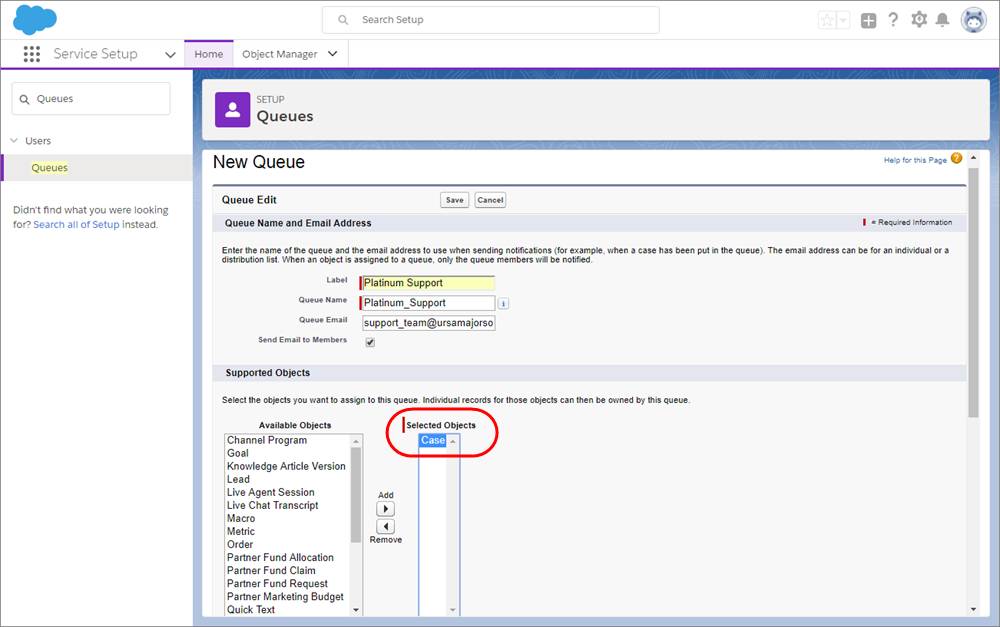
- Add members, including yourself, to the queue and save your changes. Now that the queue is created, let’s check it out as if we were support reps. We can get there with a few clicks.
- Select the Service Console app from the App Launcher. Then click the Cases tab.
- From the View list, choose Platinum Support.
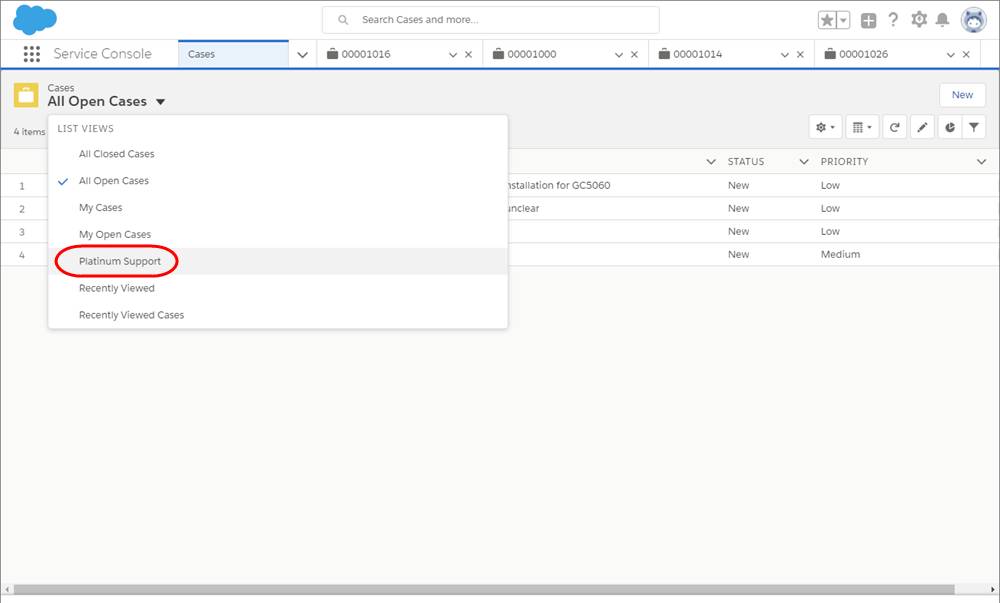
- Here’s the queue, which is empty at this time.

Add Automatic Case Assignment with Rules
While planning for case automation, Maria learns that she can assign incoming cases to one person, groups of people, or even queues. Since some support reps at Ursa Major Solar work on solar panel installation, she creates an assignment rule so that any case with a reason that includes “installation” is automatically assigned to them. This is what she does.
- From Service Setup, enter
Case Assignment Rulesin the Quick Find box, then select Case Assignment Rules.
- Click New.
- Type
Solar Panel Installationand save your changes.
- Select the rule you just created, and next to Rule Entries, click New. Here’s where we add the little details that determine case assignment.
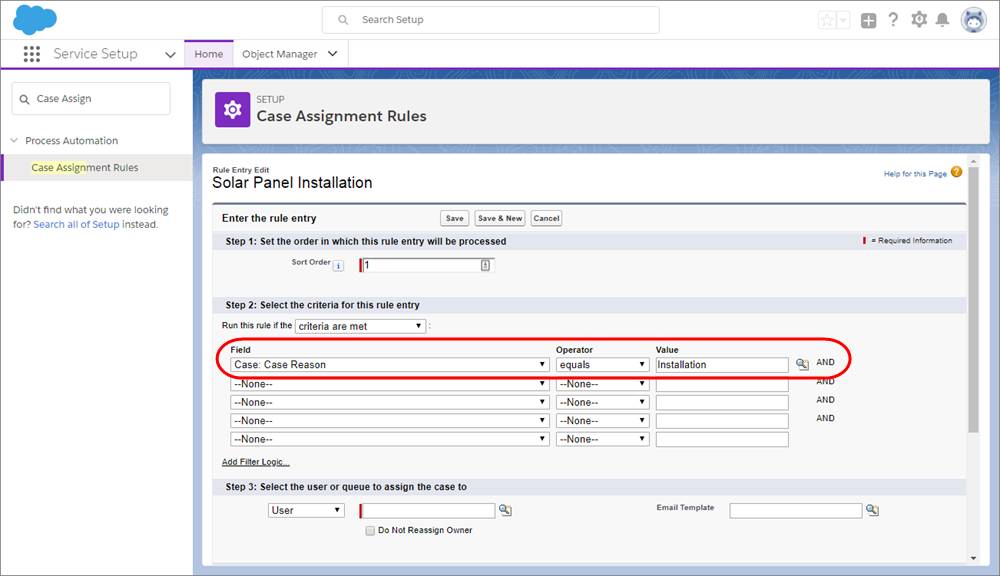
- In Sort Order, type
1so that the entry we add is processed first. Typically, you’d create one assignment rule with many different entries, which are processed in chronological order. When a case matches an entry, it’s assigned without proceeding to other entries.
- For entry criteria, select Case: Case Reason equals Installation. One of the many useful things about case assignment rules is that you can determine how cases are assigned based on fields from records other than cases. For example, you can choose case assignment based on fields from accounts, contacts, assets, or users.
- Add yourself as the User assigned to the rule entry. We assume you’re a support rep who’s an expert at solar panel installation.
- In Email Template, click the lookup and choose a template so that you receive an email whenever a case with an installation reason is assigned to you.
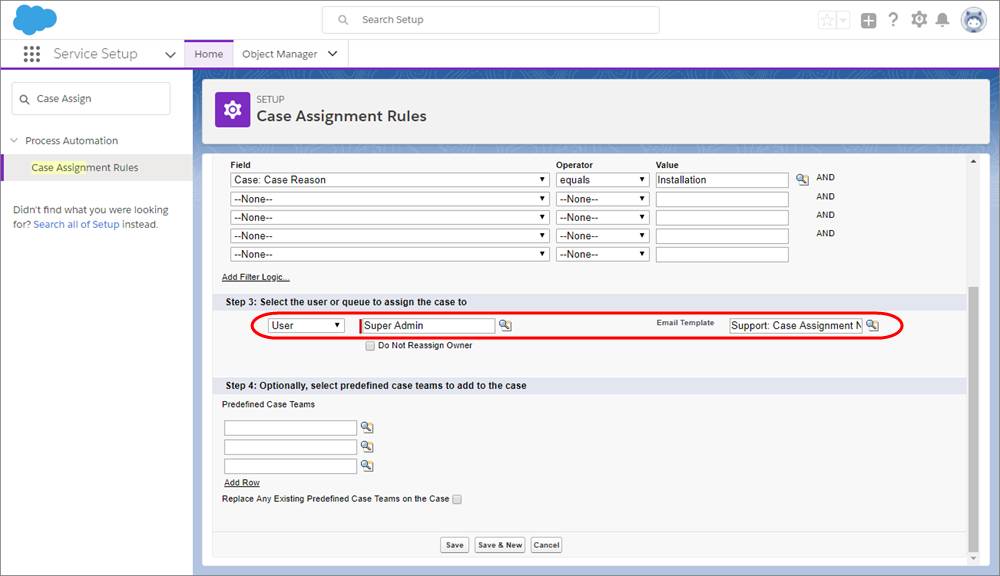
- Save your changes.
- Click Edit to mark the rule as Active, then save your changes. When you activate an assignment rule, it disables any other assignment rules in your organization, so make sure that your active rule includes all of the assignment entries that your support team needs.
Now any cases about installation issues are automatically assigned.
Add Automatic Case Escalation with Rules
When planning case management with the service team, Maria learns that certain cases must escalate to the right person within 5 hours. A lingering customer case can ruin a big deal or tarnish Ursa Major Solar’s brand. Just like assignment rules, Maria can use escalation rules to specify criteria that automatically trigger an action on a case. For case escalation, she uses her org’s default business hours, which simply means the service team is available 24 hours a day, 7 days a week. She can change Business Hours later from Company Settings in Service Setup. Here’s how Maria sets the rule.
- From Service Setup, enter
Escalation Rulesin the Quick Find box, then select Escalation Rules.
- Click New.
- Type
Gold Support, then Click Active and save your changes. Activating a rule deactivates any existing active rules.
- Select the rule you just created, and click New to add a rule entry. Here’s where we add the details that determine when the case gets escalated.
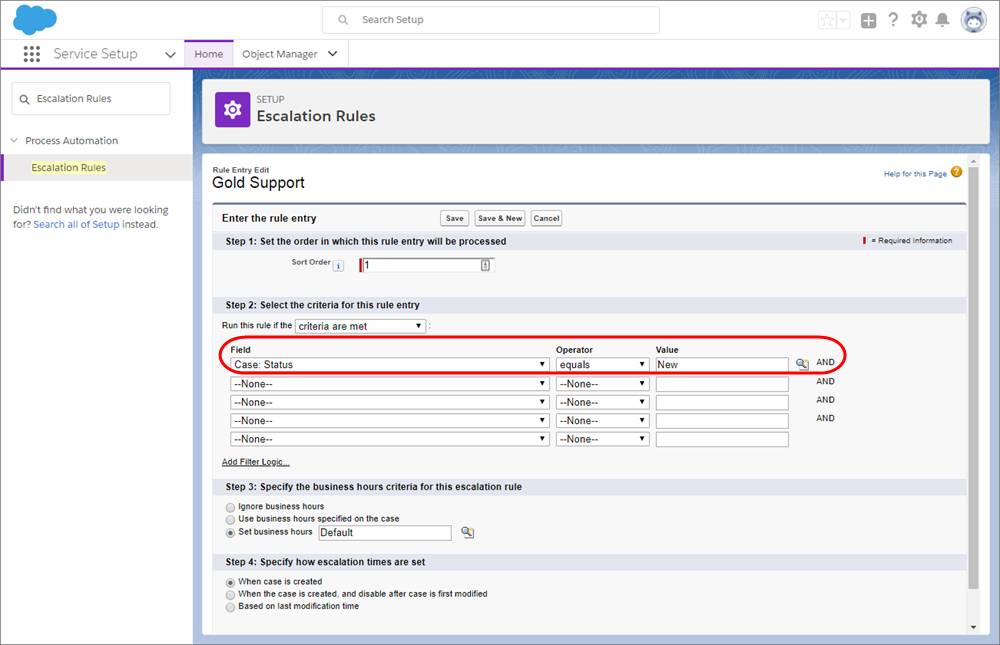
- In Sort Order, type
1so that the entry we add is processed first. In the real world, you’d create one escalation rule with many different entries, which are processed in chronological order. When a customer issue comes in and is converted to a case, it’s assigned based on the first entry it matches.
- For entry criteria, select Case: Status equals New. Similar to other rules, you can determine automatic case escalation based on fields from records other than cases.
- Set business hours to your organization’s default 24/7 support.
- Set that escalation times are based on when cases are created.
- Save your changes, then New to add an escalation action.
- In Age Over, enter
5. Here, 5 is the number of hours at which cases escalate when they have a status of New. Remember, we want cases Closed after 5 hours. You can set up escalation actions in 30-minute increments by selecting 30 from the minutes dropdown.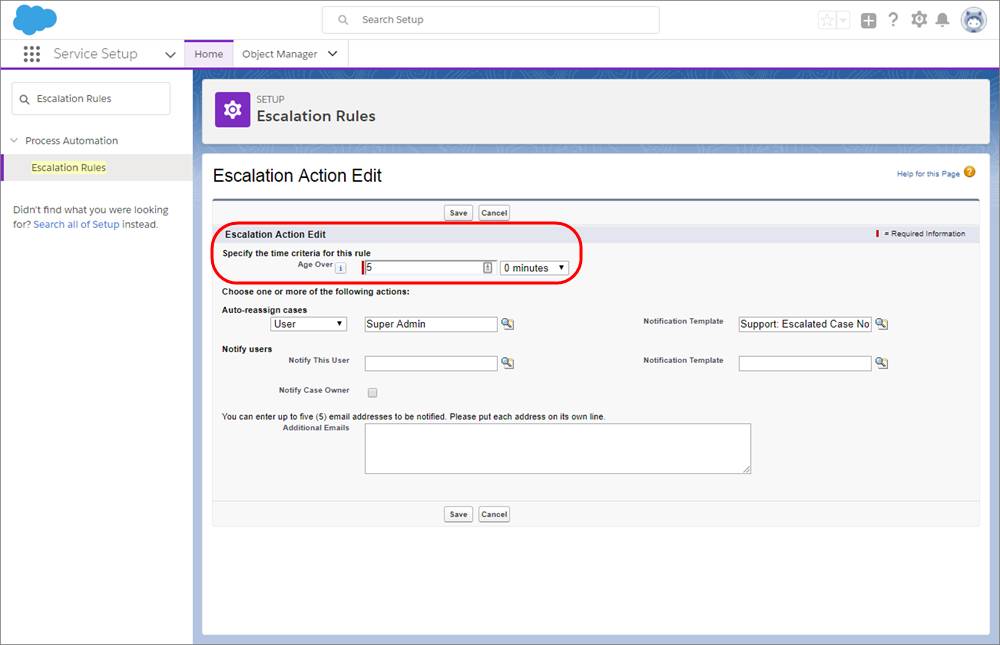
- Auto-assign cases to you, and from Notification Template, click the lookup icon to pick any template. At a real company, you’d assign cases to a support manager or team.
- Select yourself as the user to notify, and from Notification Template, click the lookup icon to add a template to see how this works.
Save your changes.
Now any cases that haven’t been closed in 5 hours are assigned to the right person.
Note: To keep the Assign using active assignment rule box checked by default on cases, update the Layout Properties on case page layouts.
Add Automatic Responses to Customers with Rules
From Maria’s case automation planning, she knows the service team wants customers to receive a confirmation when their case is received. With auto-response rules, she can make sure each Ursa Major Solar’s customer knows that their voice is heard. She sets up response rules so that customers are automatically sent a personalized email when they ask for help. Here’s how she does it.
- From Service Setup, enter
Case Auto-Response Rulesin the Quick Find box, then select Case Auto-Response Rules.
- Click New.
- Type
Welcome to Support, then Click Active and save your changes. Activating a rule deactivates any existing active rules.
- Select the rule you just created, and click New to add a rule entry. Here’s where we add a few details that determine which email template we send to a customer.
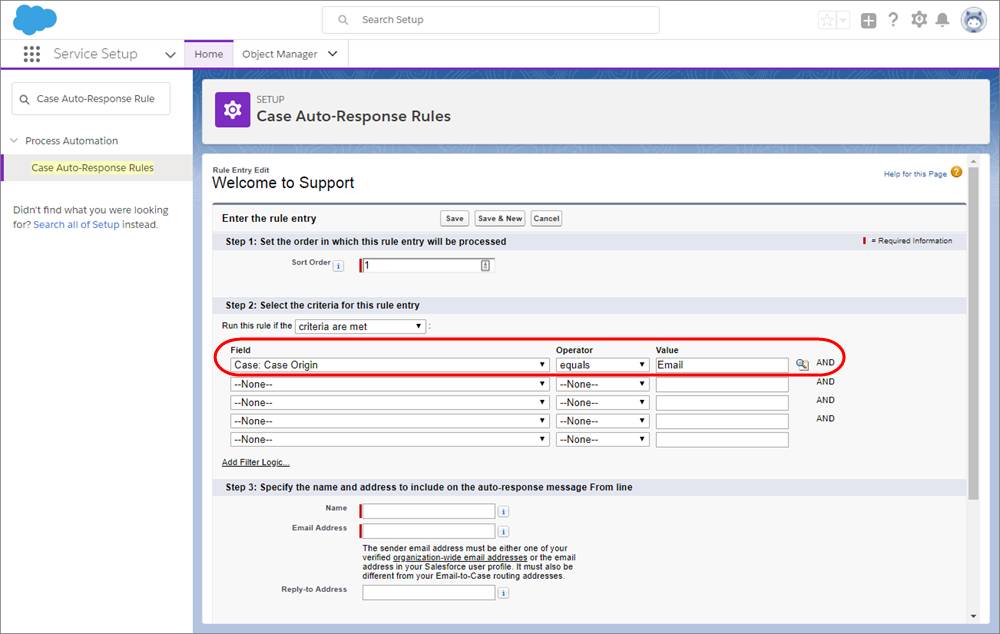
- In Sort Order, type
1so that the entry we add is processed first. In the real world, you’d create one response rule with many different entries, which are processed in chronological order. When a customer issue comes in and is converted to a case, it’s assigned based on the first entry it matches.
- For entry criteria, select Case: Case Origin equals email. Similar to escalation rules, you can determine the automatic response to send to a customer based on fields from records other than cases.
- Add a name and email address to include in the From line of the email template to send to customers.
- From the lookup field, pick any template to see how this works.

- Save your changes and you’re done!
More Case Management Tools in Salesforce
With basic case automation complete, the service team at Ursa Major Solar is looking forward to easier, faster service. But Sita and Roberto want to make the most of their Service Cloud investment. They wonder what other case management tools the team can use in the future.
Maria looks into more case management options. She jots down these discoveries to share.
Tool |
Description |
|---|---|
Agentforce for Service |
Resolve customer cases autonomously with trusted conversational AI agents. Respond to customers across channels 24/7 with natural responses and free up your service team to do more complex work. |
Page Layout Editor |
Customize a case page’s contents, like the fields and buttons that appear on the page, along with what is visible to whom. Additionally, customize the structure of the page, and the position of its components, with the Lightning App Builder. |
Email Templates |
Create email templates to save time and standardize communications sent to customers from cases. Automate information on emails with merge fields. Templates are automatically available to anyone in the org. |
Entitlement Management |
Provide the correct level of support for customers. Define, enforce, and track service agreements and service contracts as part of an overall support management process. |
Omni-Channel |
Manage support reps’ priorities and their capacity to take on work items so that they’re given only the number of assignments that they can handle. Route all assignments to the correct reps so that they no longer have to choose work assignments manually from a queue. |
Macros |
Help support reps automatically complete repetitive tasks on cases, such as selecting the right email templates, so that they can spend time doing more important things. |
Quick Text |
Create predefined messages for support reps, like greetings, answers to common questions, and short notes to insert in cases, emails, web chats, and more. Save time and standardize on messaging to customers. |
Utilities |
Give support reps quick access to productivity tools, like notes, history, softphones, and more in the footer of the console. |
Sita and Roberto want to explore some of these tools when they return to the case management stage of their service journey. But for now, they’d like to jump ahead to the basics of digital engagement.
Resources
- Salesforce Help: Set Up Queues
- Salesforce Help: Assignment Rules
- Salesforce Help: Set Up Escalation Rules
- Salesforce Help: Set Up Auto-Response Rules
- Trailhead Module: Lightning Experience Customization
- Trailhead Module: Agentforce for Service
